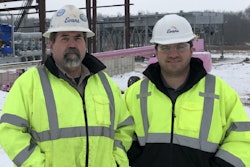 Toby Drake (right) and Daniel Paajanen, the company chief technology expert, next to one of the barges they will use to transport equipment and materials up the coast of Alaska once the sea ice thaws.
Toby Drake (right) and Daniel Paajanen, the company chief technology expert, next to one of the barges they will use to transport equipment and materials up the coast of Alaska once the sea ice thaws.
To have any hope of hitting their annual budgets this year many contractors will need to put the pedal to the metal when the coronavirus restrictions are finally lifted. And even then there will be logjams, crowded jobsites, shortfalls in materials, logistical hiccups and delays in getting permits and maybe even payments.
Such scenarios are par for the course in Alaska, however, where everybody has to get 12 months of work done in, at best, six months.
Our 2020 Contractor of the Year, Toby Drake, owner of Drake Construction in Kotzebue, Alaska, is no stranger to shortened seasons. Working 33 miles above the Arctic Circle, where the sun doesn’t come up for a month in winter and doesn’t go down for a month in summer, in wind chill temperatures that drop below minus 30-degrees on a regular basis, Drake’s approach to construction is well worth studying for any contractor who has lost a portion of their construction season to the Coronavirus.
 A grader pulls the barge ashore to secure it at a construction site.
A grader pulls the barge ashore to secure it at a construction site.Drake doesn’t offer any magic solutions, however. He says there are really only three key words to remember when working in Alaska: planning, planning and planning.

And we’re not just talking operations plans, but logistics, trucking, finances, equipment availability and utilization, personnel, bidding and estimating, subcontractors, weather delays and materials. Even small changes to your external circumstances will ripple through almost all aspects of your company.
“We just picked up a new job for this year worth about $3 million,” Drake says. “I have been planning for what happens if its delayed anywhere from a week to two months. With the Coronavirus it’s obvious you have to make a lot more plans now, because once we’re on the downhill side of things it’s going to be blow and go. If we’re just now beginning to plan for that job, it’s not going to happen.”
 In a weather-shortened season you do whatever it takes, including flying equipment to the job site in a cargo plane.
In a weather-shortened season you do whatever it takes, including flying equipment to the job site in a cargo plane.Drake learned this lesson early on from his father Wayne, who is retired now, but started the company decades ago. He says he distinctly remembers as a teenager coming home in the wee hours of the morning after a night of carousing with his buddies and seeing his dad at the kitchen table, yellow legal pad in hand, writing out detail after detail of what had to happen next to keep the jobs moving and the money coming in.
Alaska has state guidelines on what you can and can’t do regarding the coronavirus. Because of the cold and snow, the construction season hasn’t started yet, but the state DOT has already put out its own guidelines and many of the small towns and native villages have their own protocols.

For concern over the health of many of the elders in the tribal villages people who don’t live in the villages aren’t even allowed to come within shouting distance of any of the residents for anything. This adds another layer of complexity to the planning process for Drake and all the contractors who work in Alaska.
Drake Construction, however, takes all these complications in stride. It’s business as usual.
In addition to having to work with three federal regulatory bodies: OSHA, MSHA and the Coast Guard (they run equipment and materials on barges), Drake as a matter of routine must also work with federal and state agencies as well as tribal councils, and sometimes deal with all of these entities for just one project.
 33 miles above the Arctic Circle, Drake’s construction operations put the health and well being of the Native American villages and elders they serve above all other considerations.
33 miles above the Arctic Circle, Drake’s construction operations put the health and well being of the Native American villages and elders they serve above all other considerations.But as a Native American from the Athabaskan tribe in Alaska, Drake is all too aware of the importance of the Coronavirus restrictions and has no complaints.
“We all agreed to delay one project 30 days just to see what happened,” he says. “And we’ve been keeping in close contact with all our ongoing projects. Every life is more important to us than a construction project.”
The Contractor of the Year program has been sponsored by Caterpillar for 21 years. For more information, click here.
 The big barges are rolled up on airbags at the end of the season and rolled back out to sea when the ice thaws.
The big barges are rolled up on airbags at the end of the season and rolled back out to sea when the ice thaws.
 Equipment heads up river on one of Drake’s smaller barges.
Equipment heads up river on one of Drake’s smaller barges.
 The company’s pit is located a few miles upriver from Kotzebue. From here with his fleet of barges, Drake can supply all his own gravel needs and fill orders for other contractors working in northwest Alaska.
The company’s pit is located a few miles upriver from Kotzebue. From here with his fleet of barges, Drake can supply all his own gravel needs and fill orders for other contractors working in northwest Alaska.













